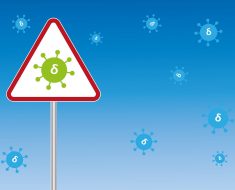Allergies and asthma are two (unfortunately) common maladies. Some signs and symptoms of these conditions are obvious, while others are a little sneakier. Here are some of the common (and not-so-common) signs and symptoms of allergies and asthma.
Asthma signs & symptoms
Asthma describes a chronic lung disease that negatively impacts your airways, rendering them swollen or inflamed, which makes it hard to take air in or breathe it out, according to the National Heart, Lung and Blood Institute. Asthma can be triggered or worsened by certain conditions (such as the presence of a cold virus, dust, exercise or allergens), or it can be something that always seems to be present, the NHLBI explains. It can be a minor irritation for some people, but for others, it can be severe enough that it causes impactful problems on a daily basis, and it can even be life-threatening.
Asthma signs & symptoms
Asthma affects more than 25 million people in the U.S. according to statistics from Johns Hopkins University, and while most cases start in childhood, not all of them do. Also, according to Dr. Phil Boucher, a pediatrician in Lincoln, Nebraska, most kids do outgrow asthma, but not all, so it may be something you’ve been dealing with since childhood. "Children with mild and moderate asthma often outgrow it as they go through their teenage years," he tells SheKnows. "However, asthma does persist into adulthood for some patients, especially if it’s strongly associated with allergies." How do you recognize asthma, anyway?
Here are some symptoms as described by the NHLBI:
Wheezing: Wheezing is one of the hallmarks of asthma and is notable because other people can often hear it too. Wheezing is a squeaky or whistling sound that happens when you breathe in — or out.
Coughing: While you may think all coughs are created by colds, it’s actually a more common sign of asthma, especially if it’s worse at night and negatively impacts your sleep.
Chest tightness: This decidedly unpleasant symptom makes it feel like something is sitting on your chest or someone is giving you a huge bear hug and won’t let go.
Shortness of breath: Another symptom that can be alarming for those experiencing it is shortness of breath. It makes you feel like you can’t take a deep, satisfying breath, or it could also manifest itself as making you feel like you can’t exhale completely.
It’s important to get a proper diagnosis if you’re experiencing what you think is asthma, as proper treatment can limit or eliminate your asthma symptoms. Your doctor can advise what to do in certain situations (including when it’s time to seek emergency care — because asthma attacks can be fatal) and will help create an asthma action plan, which will help you manage your condition at home, including what medications to take and when to take them.
Allergy signs & symptoms
Unfortunately for us human beings, there are loads of different types of allergies, from the dreaded watery-eyed nasal disaster that is seasonal allergies to life-threatening allergic reactions from eating a pecan (or other seemingly harmless food). People can be allergic to pollen, dust mites, mold, pets (wah!), food, insect stings and medicines. This is all bad news, and if diagnosed, you might have to completely alter your habits and surroundings and arm yourself with emergency meds to ward off a fatal event.
Here are some of the signs and symptoms of different types of allergies as described by the American Academy of Allergy Asthma and Immunology, all of which are a drag and some of which can be deadly.
Hives: Hives are also known as urticaria, and they’re itchy red bumps that can range in size from tiny to palm-size.
Asthma: Asthma can be triggered by allergens, including pet dander and pollen. Asthma sufferers often notice their symptoms are worse during certain parts of the year or in homes with the pets they’re allergic to.
Eye problems: Allergies can also impact the whites of your eyes, turning them pink, and can also lead to itching and swelling.
Eczema: Allergens can also cause skin problems, and eczema manifests itself by itching, flaking, peeling and reddening.
Nasal problems: Your snout can also give you trouble. Symptoms can include facial pressure, nasal congestion and a thick nasal discharge and can indicate sinus problems triggered by allergens.
Nasal salute: Boucher also mentioned the "nasal salute" as an uncommon sign of allergies, and it can affect kids and adults alike. He describes it as pushing up on their nose, both to deal with the itch, and also to move the snot around. Over time, this can lead to a semipermanent crease across a patient’s nasal bridge — so if you’re constantly rubbing your nose and aren’t really aware of it, a nasal crease can be a sign that you’ve got allergies.
A note about anaphylaxis
Anaphylaxis is a super-serious allergic reaction and can be triggered by just about any old allergen, but the most common culprits are foods, insect stings, medications and latex according to the Mayo Clinic.
Symptoms of anaphylaxis, per the American Academy of Allergy Asthma and Immunology, include (but are not limited to):
- A feeling of warmth
- Flushing
- Hives
- Lightheadedness
- Pale coloration
- Shortness of breath
- Throat tightness
- Nasal congestion
- A generalized feeling of doom
- Anxiety
- Stomach pain
- Vomiting
- Diarrhea
Without prompt treatment, anaphylaxis can be fatal, and doctors typically provide EpiPen prescriptions for those with allergies that are more prone to serious reactions. Symptoms can escalate quickly, so use the EpiPen first and call 911 for transport to a hospital instead of waiting to see if symptoms improve, because they might not, and you can get to the point where epinephrine doesn’t work.
Managing asthma & allergies is possible
With a proper diagnosis and a good treatment plan, it’s possible to manage allergies and asthma. There is a variety of treatment options for either or both, and while there is typically no cure for either condition, symptoms can be reduced or eliminated, and you can sleep better and have less worry once these conditions are under control.
Source: Read Full Article





